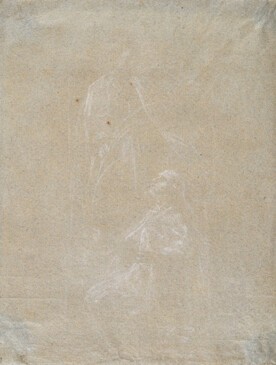- Cronología
- Ca. 1790
- Ubicación
- Parish church of Ntra. Sra. de la Asunción, Valdemoro (Madrid), Spain
- Dimensiones
- 250 x 90 cm
- Técnica y soporte
- Oil on canvas
- Reconocimiento de la autoría de Goya
- Undisputed work
- Titular
- Diocese of Getafe
- Ficha: realización/revisión
- 24 Jan 2010 / 28 Jun 2023
The Count of Lerena, who came from Valdemoro (Madrid), steward and secretary of state under King Charles III and Minister of the Treasury under Charles IV, took over the patronage of the local church in 1790 and commissioned a new altarpiece comprising three canvases to be created. The centre painting, commissioned to Francisco Bayeu, was dedicated to the Assumption of the Virgin. The left-hand piece, painted by Ramón Bayeu, is the Martyrdom of Saint Peter of Verona. The right-hand painting, dedicated to Saint Julian, is the work of Goya.
The central scene is signed and dated 1790, and we can assume that the lateral paintings were completed around the same date
There is no specific document attesting to Goya's authorship of this painting, but today all specialists agree that it is his work following publications by Sánchez Cantón and Xavier de Salas which cleared up any doubts over their previous attribution to the Bayeus, linking it definitively to Goya, above all by pointing out its connection to a drawing of the same name by that painter.
The subject is based on the Flos Sanctorum by the Jesuit priest Pedro Ribadeneyra, which narrates the lives of the saints according to the liturgical calendar, published for the first time in 1599. It shows the Virgin crowned with flowers, dressed in a pink tunic and blue mantle. She appears to Saint Julian, the Bishop of Cuenca, who knees before the apparition, giving her the martyr's palm. To one side there is an unfinished basket, a crosier and miter, the symbols of the sainted bishop. He is elegantly dressed in a richly decorated and gilded cope. The white of his tunic stands out against the dark background. Once again we are presented with a devotional scene located in a dark room and illuminated thanks to the light radiating from the characters themselves, above all from the Virgin's halo.
Goya's versatility of technique is striking, as is the contrast between different sections of the painting: the impressionist treatment of the Virgin's crown of flowers or the Saint's cope contrasts with the attention to detail and realism of the wicker basket or Saint Julian's face.
The painting was restored in the rooms of the Conde Duque Cultural Centre in 1988 for its first exhibition outside its original location "Painters of the Enlightenment" (Los pintores de la Ilustración), since it was badly damaged and poorly conserved.
-
Los pintores de la IlustraciónCentro Cultural Conde DuqueMadrid1988consultant editors José Manuel Arnaiz and José Luis Morales y Maríncat. 56
-
Goya (1746 – 1828)Galleria Internazionale d’Arte Moderna di Ca’PesaroVenecia1989consultant editor Antonio Fortún Paesa. From May 7th to July 4th 1989cat. 31
-
Goya. La imagen de la mujerMuseo Nacional del PradoMadrid2001from October 30th 2001 to February 10th 2002. Exhibitied also at the National Gallery of Art, Washington, March 10th to June 2nd 2002, consultant editor Francisco Calvo Serrallercat. 49
-
Goya e ItaliaMuseo de ZaragozaZaragoza2008organized by the Fundación Goya en Aragóna, consultant editor Joan Sureda Pons. From June 1st to September 15th 2008cat. 281
-
El Goya de ValdemoroArchivo Español del ArteMadrid1964
-
Vie et ouvre de Francisco de GoyaParísOffice du livre1970pp. 79, 96, cat. 246
-
BarcelonaPolígrafa1970vol. I, p. 282, cat. 294
-
L’opera pittorica completa di GoyaMilanRizzoli1974p. 105, cat. 249
-
Francisco de Goya, 4 vols.ZaragozaCaja de Ahorros de Zaragoza, Aragón y Rioja1980-1982vol. II, p. 82 y p. 195 (il.)
-
Goya e Italia, 2 vols.ZaragozaFundación Goya en Aragón y Turner2008vol. II, p. 306, cat. 281

